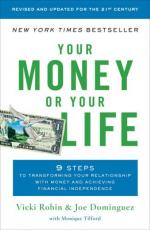
|
| Name: _________________________ | Period: ___________________ |
This test consists of 5 multiple choice questions, 5 short answer questions, and 10 short essay questions.
Multiple Choice Questions
1. How is a real hourly wage figured?
(a) Divide real pay by real hours worked.
(b) Divide real pay by actual hours worked.
(c) Divide real hours worked by work expenses.
(d) Divide real hours worked by real pay.
2. What are piggy banks and cookie jars examples of?
(a) Savings categories.
(b) Places where a person should never keep money.
(c) Items too fragile to hold anything but paper money.
(d) Symbols to place next to money-saving items in a monthly chart.
3. Question 3 asks participants to consider what it would be like to do what?
(a) Retire.
(b) Conserve life energy.
(c) Find a life mission.
(d) Eliminate debt.
4. What does Question 1 help people figure out?
(a) How to increase income.
(b) How they could increase or decrease spending to feel more fulfilled.
(c) How to eliminate debt.
(d) How to choose a new career.
5. What makes the difference between a good life and a great life?
(a) A good job or a great job.
(b) Having more leisure time than work time.
(c) Being poor versus being rich.
(d) Contributing money, energy, or time after having enough.
Short Answer Questions
1. What is the final part of Step 3?
2. Which perspective is feeling connected to a certain social class part of?
3. What does Question 2 help people to figure out?
4. What items are included in everything owned?
5. What can help people determine what they value?
Short Essay Questions
1. What are some of the not-so-obvious expenses related to a person's work?
2. Why do many people give up on their dreams early in life?
3. Where does the "rat race" come from?
4. What is the first part of Step 1? What is its purpose?
5. For Step 4, what is the first question program participants should ask, regarding every expense on their chart? How does the chart answer the question?
6. Whenever people spend money, what more valuable commodity are they also spending?
7. Why is it beneficial to be specific with categories, rather than more general?
8. How does our consumption hurt the environment?
9. What do the two parts of Step 2 allow program participants to track?
10. What perspective of money do the authors endorse? Why?
|
This section contains 813 words (approx. 3 pages at 300 words per page) |

|




